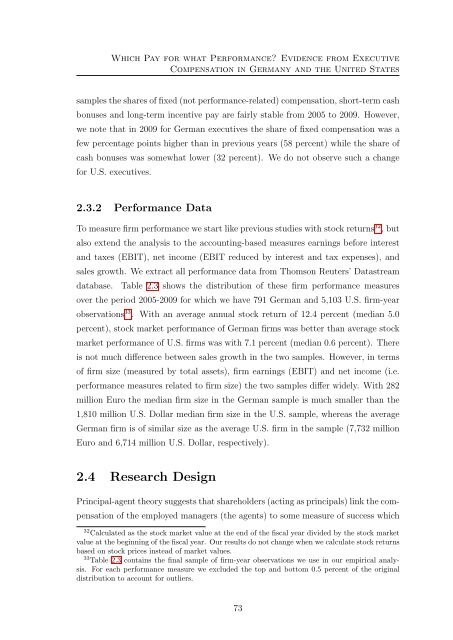Three Essays on Executive Compensation - KOPS - Universität ...
Three Essays on Executive Compensation - KOPS - Universität ...
Three Essays on Executive Compensation - KOPS - Universität ...
Create successful ePaper yourself
Turn your PDF publications into a flip-book with our unique Google optimized e-Paper software.
Which Pay for what Performance? Evidence from <strong>Executive</strong><br />
Compensati<strong>on</strong> in Germany and the United States<br />
samples the shares of fixed (not performance-related) compensati<strong>on</strong>, short-term cash<br />
b<strong>on</strong>uses and l<strong>on</strong>g-term incentive pay are fairly stable from 2005 to 2009. However,<br />
we note that in 2009 for German executives the share of fixed compensati<strong>on</strong> was a<br />
few percentage points higher than in previous years (58 percent) while the share of<br />
cash b<strong>on</strong>uses was somewhat lower (32 percent). We do not observe such a change<br />
for U.S. executives.<br />
2.3.2 Performance Data<br />
To measure firm performance we start like previous studies with stock returns 32 , but<br />
also extend the analysis to the accounting-based measures earnings before interest<br />
and taxes (EBIT), net income (EBIT reduced by interest and tax expenses), and<br />
sales growth. We extract all performance data from Thoms<strong>on</strong> Reuters’ Datastream<br />
database. Table 2.3 shows the distributi<strong>on</strong> of these firm performance measures<br />
over the period 2005-2009 for which we have 791 German and 5,103 U.S. firm-year<br />
observati<strong>on</strong>s 33 . With an average annual stock return of 12.4 percent (median 5.0<br />
percent), stock market performance of German firms was better than average stock<br />
market performance of U.S. firms was with 7.1 percent (median 0.6 percent). There<br />
is not much difference between sales growth in the two samples. However, in terms<br />
of firm size (measured by total assets), firm earnings (EBIT) and net income (i.e.<br />
performance measures related to firm size) the two samples differ widely. With 282<br />
milli<strong>on</strong> Euro the median firm size in the German sample is much smaller than the<br />
1,810 milli<strong>on</strong> U.S. Dollar median firm size in the U.S. sample, whereas the average<br />
German firm is of similar size as the average U.S. firm in the sample (7,732 milli<strong>on</strong><br />
Euro and 6,714 milli<strong>on</strong> U.S. Dollar, respectively).<br />
2.4 Research Design<br />
Principal-agent theory suggests that shareholders (acting as principals) link the compensati<strong>on</strong><br />
of the employed managers (the agents) to some measure of success which<br />
32 Calculated as the stock market value at the end of the fiscal year divided by the stock market<br />
value at the beginning of the fiscal year. Our results do not change when we calculate stock returns<br />
based <strong>on</strong> stock prices instead of market values.<br />
33 Table 2.3 c<strong>on</strong>tains the final sample of firm-year observati<strong>on</strong>s we use in our empirical analysis.<br />
For each performance measure we excluded the top and bottom 0.5 percent of the original<br />
distributi<strong>on</strong> to account for outliers.<br />
73
















